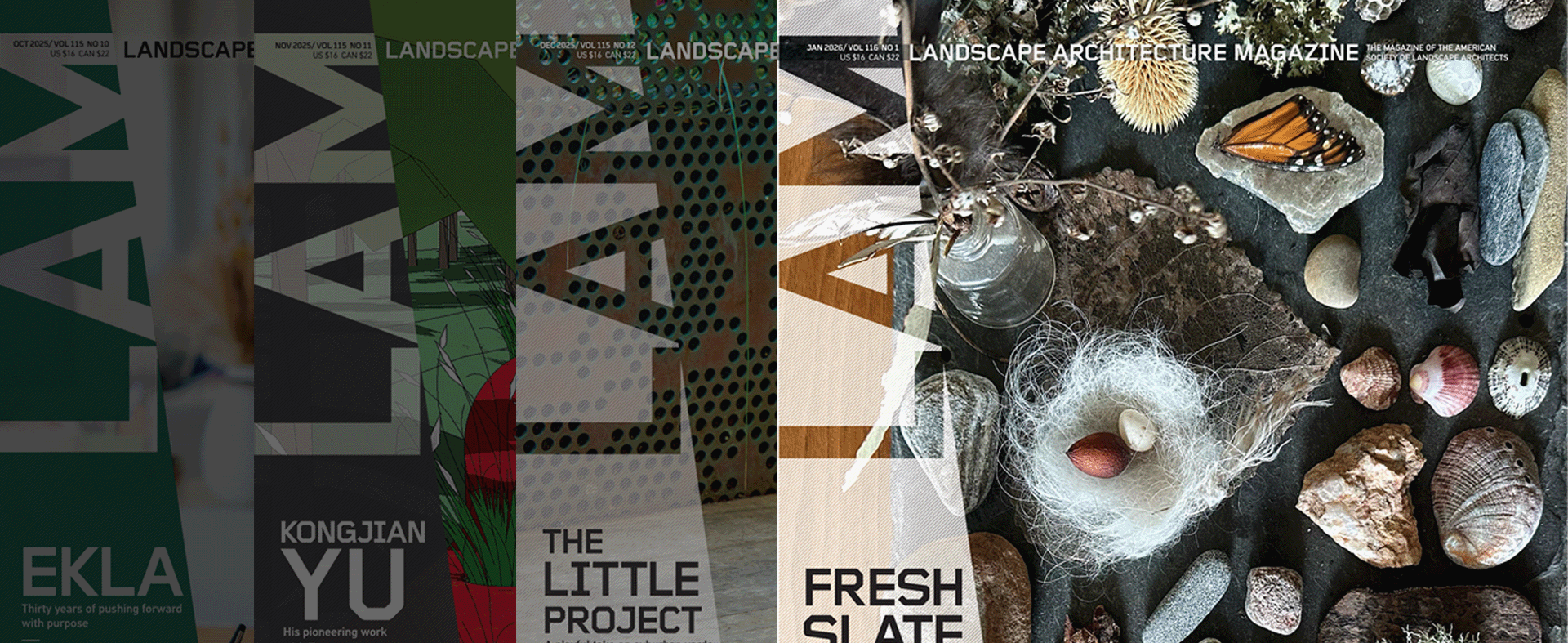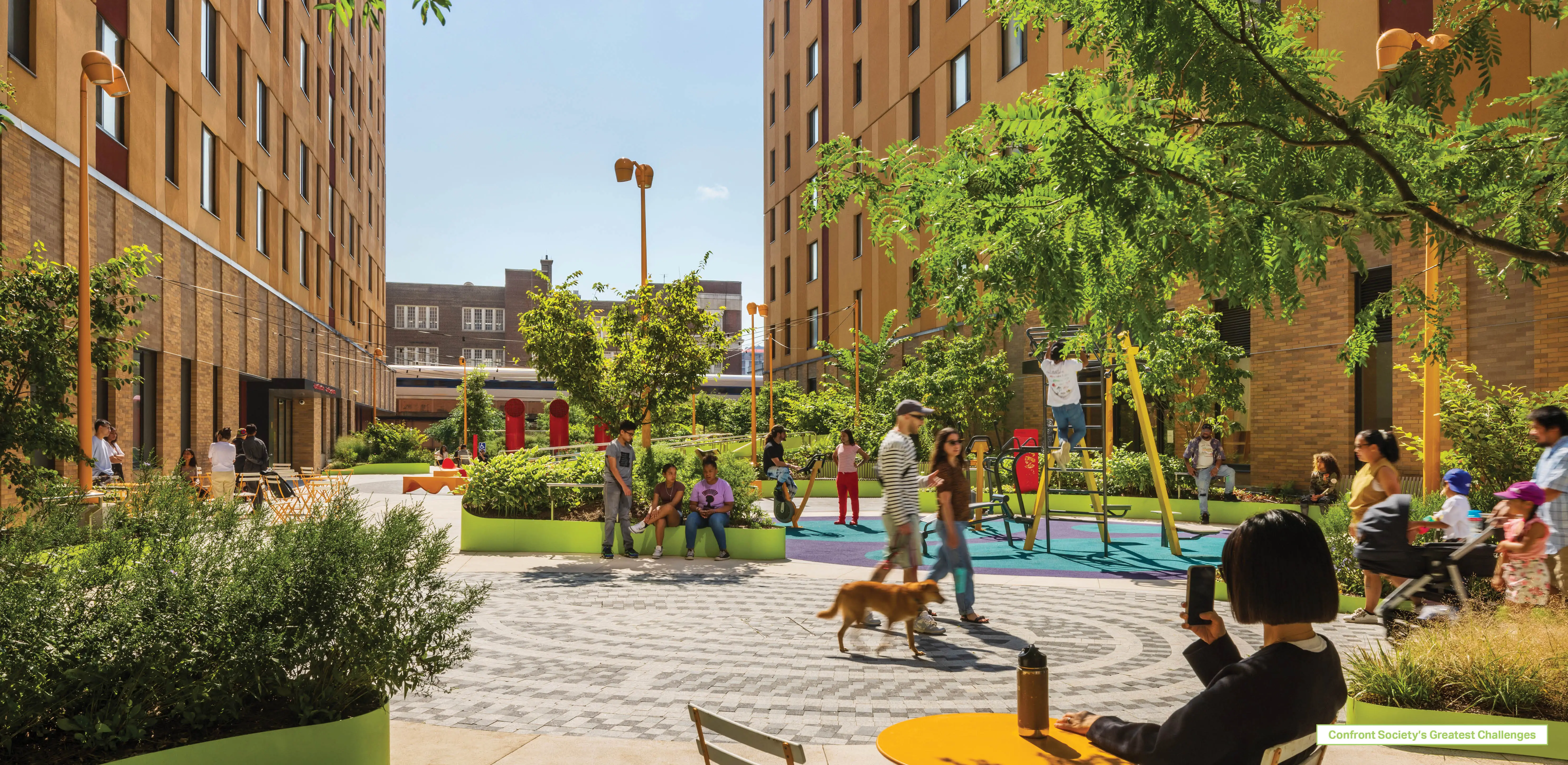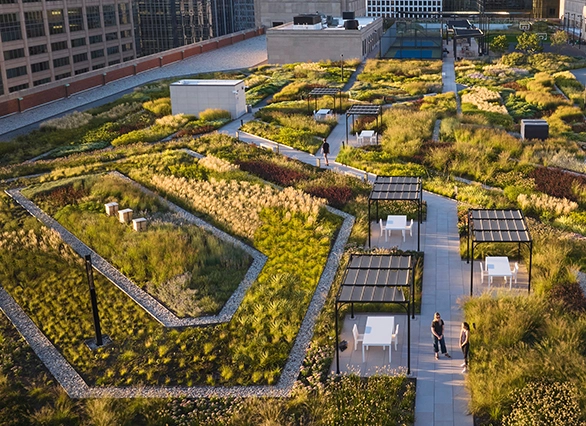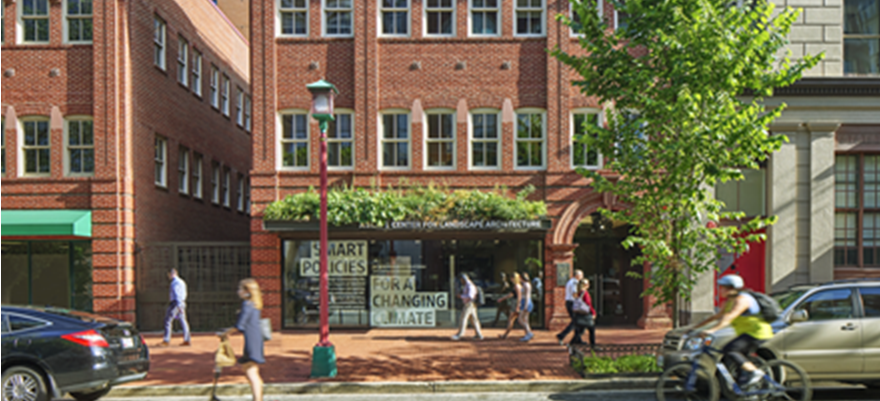Martha Schwartz, FASLA
on the Power of Design
In 2008, you wrote in BBC News that "landscape architects lag behind architects in the conversation around sustainability" and are relegated to dealing with green roofs. Almost four years later, do you still think this is true?
Definitely not as true. There has been a real ascendancy of the profession. We are now being recognized as able to lead urban-scale design and planning efforts, to define the issues, generate strategies for what needs to be done in the structuring and enabling of the project, set the environmental agenda, and then create the structure for community engagement. Of course, we are also able to bring this more strategic level of thinking into a physical design. We are often brought in advance of the architects since our agenda does not necessarily include building buildings. Clients feel more secure knowing that it is not a forgone conclusion that complex urban issues do not always resolve in buildings. We now able to organize larger teams to tackle these complicated issues that cities have.
Right now, people are not that interested in building iconic buildings. They're trying to figure out how to fix, expand, shrink, or build their city. We are the profession most able to synthesize the many different systems that make a city work. As informed generalists, we can handle a huge amount of information across many topics and still come to a conclusion about what needs to happen.
The process is more open-ended and more collective. A site has a finite environmental holding capacity. Based on what those constraints are that are generated by the environment, the next series of “systems” that must be considered is what I call the “soft” systems - the social, cultural, and economically-based systems. All of these forces are played out upon the urban landscape. Cities are growing and so are now becoming a major environmental issue. We can build them so they are a positive effect on our global environment or we can build them so they are a detriment. So the topic of the urban landscape is becoming very urgent and important.
In the same article you call for a focus on the "softer side of sustainability," which involves developing more sustainable communities where there's a "sense of place, identity, and belonging." One way to do this is "careful and inspired design which can make all the difference between a place that is viewed as no real significance to anyone and a place that attracts people creates vitality and is cherished by its inhabitants." Do you think more communities have been getting the message?
I know that a few larger American cities are, but in general, I don’t think the U.S. has really gotten to this point. America has had an uneasy relationship with cities. The Europeans have lived in dense cities historically and therefore have been aware of the value of making their cities attractive for a long time. But even cities in developing countries understand that to attract people they need to make their cities attractive. Yes, insight is playing out around the world.
But for most Americans: the idea that sustainability is linked to the way our environment looks is a stretch. However, there is much scientific evidence now that proves that the quality of our physical environment has psychological and emotional impacts upon us. We are working on a hospital in Vienna where the landscape is incorporated into the financial pro-forma of the operation of the hospital. They know that if they build landscapes that the patients enjoy then they can move the patients out more quickly. In the U.S., physical design is viewed as “non-functional” and seen as just a cherry on top of the cake. It is a mystery to me why this close relationship between what something looks like and its value is not more fully appreciated by Americans. It is understandable when it comes to electronics, cars or fashion, but when this is applied to cities people generally go blank.
The "softer side of sustainability” is just my way of saying that the urban landscape is not only about technical or science-based systems. The urban landscape is greatly shaped and organized and enables what people think, feel, and do. To design in the city, there must be a recognition of ALL the systems, the natural and the people systems that must be accounted for. A project designed without an understanding of these domains will not be able to resolve a landscape that is balanced, nor will it last long. One definition of sustainability is that something will have longevity. Longevity in the urban environment can only be achieved if people value it. If people value something, they will tend to invest in it and keep it. It becomes important to them and therefore sustains. But things and places that are not valued or attractive to people in some way, become degraded, and will eventually fail.
What design can do is create streets, spaces, and neighborhoods that attract people. Everybody knows you pay more money to be in nice places and that almost everybody wants to be in beautiful environments. Beautiful environments and cities create desirability. This desirability creates value. People invest both economically and emotionally. The DESIGN and functionality of a city cannot and should not be seen as separate factors. Design does function on many levels. Without it, one cannot really create a livable city and cannot compete in a globalized world.
In one session at the annual meeting, you said, "Green roofs are nice, but what about sustainable cities?" At Harvard, where you teach in the School of Design, you founded the Working Group for Sustainable Cities, an interdisciplinary group of professors who are focused on urban sustainability. Bringing in lots of different academic fields must be interesting. How does that change the conversation? What are the toughest issues limiting sustainable urban development according to this group?
We are still in the business of formulating exactly how we're going to apply our collective knowledge and expertise. We hosted a series of lunches for local mayors around Boston that we ran as a fact-finding mission. We learned about the many dire issues cities are facing today.
Although many of the cities differed in specifics, in general, all the cities are hampered by money. Yet they still have to take care of the basics, while trying to plan for their future. They need to upgrade themselves so that they keep their people, their tax base, and attract businesses.
These “Mayors Luncheons,” hosted by the Institute of Politics at the Kennedy School of Government have been very valuable. Not only are we learning what we can do as a group but we're also learning what we need to be teaching our students so they can learn how to approach sustainability at a city scale. There is a great deal of information and expertise to be shared.
For teaching landscape architects we can learn to discover what the issues really are, such as how do cities operate, how do politics affect and shape environmental and economic issues? Landscape architects are being taught how to think about, define, and solve urban issues and still design them to be wonderful and valued parts of the city.
In another lecture, you seem very pessimistic about the ability of Americans to connect with "real" nature, particularly in cities, arguing that "nature today is a commodity that is inserted in bits and pieces into an environment that is itself a constructed product of our will. It does what we want and sadly all we want is to enjoy the view without being inconvenienced." Are you still pessimistic? Do you think that values are shifting towards protecting and reinvesting in nature with the younger generation?
I think that's a wrong read. I'm not pessimistic, I am realistic. People are eager to connect with nature. Our issue is that we do not see with honesty HOW we are building the landscape in our cities. IF it is not natural, then it goes un-regarded. We Americans love nature and our national parks. We love nature, but what we don't love is all the built landscape that we live and work in. We don't plan our cities so nature can play a role in it. We don't invest our money in urban landscapes because they cost a lot of money and must be planned well in advance. We don't vote for taxes to maintain our landscapes. But the reality is that we build our landscapes and build them cheaply and without much ambition for them. Look at the landscape environment of our strips -- all that in-between landscape between the gas station, the big-box developments. It is why most American cities are unattractive. We Americans have used up a great deal of our nature indiscriminately as it is viewed as a unlimited resource while still loving it at the same time.
We carry a nature myth within us as Americans. We love nature as wilderness but we don't love any built, constructed environment as it falls outside our idealized picture of nature. There's a great divide between what people consider to be landscapes of value and landscapes that are not valued. Once a landscape has been manipulated, it has no value. So we don't bring our resources to it. Codes that might demand a higher quality for its planning, design, and execution have resulted in a tremendous, almost wall-to-wall visual degradation of our environment. Through demonstration, we have built our environment through an ethos that says, “If it's not nature, we don't care about it." That's what really pains me. Our abundance of nature has provided us too much of a good thing and we have used it indiscriminately. Our ability to sprawl and use our landscape in a wasteful and neglectful way will ultimately has already greatly diminished what was a very beautiful country. Our landscape is a natural resource that is limited and has value. It must be viewed in that way.
My frustration is that people don't understand or accept the notion that we build and therefore shape our environment. We build our landscape like we build our buildings so that we could live in it. It's a built artifact and, as such, we should be thinking more critically about how we design it. Our landscapes are our streets, sidewalks, median strips, train corridors, highway right-of-ways, parking lots, on and off ramps, the back alleyways-- all that leftover space has been chopped up by roads and highways. We've built most of our constructed landscapes very carelessly and without real investment. Now most of us have to pass through miles and miles of degraded, ugly, and dispirited open spaces, which comprise our urban and suburban landscapes.
In recent years, you've been creating large-scale master and landscape plans in United Arab Emirates and Qatar. For Qatar Petroleum, you proposed a "verdant green oasis landscape" in the desert. What are the long-term sustainability issues involved in creating water-intensive developments in desert ecosystems?
In most countries, outside the United States, you can't build landscapes that are not carefully calculated to be able to survive on the water systems being produced within nearby buildings. We would never actually build anything that required more water than what we actually generate on-site. So if readers are viewing this as an unsustainable landscape, it's a misunderstanding of that plan.
We used planting in areas that both were shaded by the buildings, where there would be less transpiration, and in areas where most people would be. Where there would be little use by people, it feathered out into an absolutely arid landscape. We used the same principles in our design for the Abu Dhabi Corniche where we designed to the strict regulations required for Estidama, the UAE’s tight standards for sustainability in the landscape.
One of your projects for the late '90s, the Geraldton Mine Project, is a bold example of how to turn a degraded landscape into an economic and cultural asset. Beyond simply creating a beautiful land form, you also restored soils, re-vegetated, and created trails in an effort to lure tourists to a small town in Ontario. Does this site serve as a model for restoration for the thousands of mining sites throughout the world? What have been the challenges to scaling up this kind of approach? Why hasn't it happened more?
That's a very good question. We have worked on three mining sites, all of which have created a regeneration of those sites and their surrounds. It's an incredibly robust model for how to re-use a degraded landscape so it can again be productive. The issue with Geraldton, a very small post-mining town, is that it had run out of its economy. Post-mining, what remained was a devastated landscape and an environmentally toxic landscape. The only way the town could figure out how to survive was to try to capture the people travelling on the Trans-Canadian Highway and get them to stop. But, of course, as you were passing through this area, you would just put the pedal-to-the-metal to get out of there as quickly as possible.
The idea was to take the huge pile of mining tailings and reshape them into something that was not the natural landscape so that it contrasted with the natural landscape, which is very flat and monotonous. The concept was to take the tailings and sculpt them to create land art. As a result, people did stop. They wondered, "What is this?" or "What's happening here?" People would slow down to explore and come into the town. As a result of capturing some of their economy, they continued to develop the other parts of the site into a golf course that generated more economy and so it started to generate a new economy.
There aren't that many who understand that the landscape, the earth, trees could be seen as an artistic medium, like a box of paints. You have beautiful, living and inanimate materials, and one can create something that has cultural resonance. The narrative or idea can be about anything. All great art is, essentially, a very personal statement or inquiry. A built landscape is not required to look or mimic nature. If we are creating it, like any other cultural art form, it can be what we wish it to be. There's no law that says it has to look like nature. What if all the books or movies or plays were about one subject matter or dictated by the government? It would be stopping the evolution of culture. Without realizing it, people have very clear notions of what a landscape should be, while we're much more open about what a building can be because we know it's a cultural artifact. But to most in the U.S., a landscape must represent nature or the process of nature. I strongly disagree with this didactic view of how our landscape must be designed. It is a narrow view. Because in our cities, in the places we make for ourselves to live, the landscape could and should have cultural resonance and meaning. This is actually a necessity to making spaces that people will love and cherish and, ultimately, be sustained.
Also, do you know that the Sphinx is a mining site? That's where they mined the stone for the pyramids. They just decided they didn't want an ugly hole. They actually sculpted it and created art. It’s a wonderful example of what one can do with a quarry.
We worked in Winslow, New Jersey, on a clay quarry that had been a dump for 30 cars. It was a degraded and socially dangerous site. With the client, and an ecologist, we regenerated it so now it's an informal nature conservancy. Now, people want to know if they can buy the land to develop it into housing (no). But the point is, that now, there is a whole new set of possibilities for the site and the town. We also worked in northern England in a small post-mining village to help in the regeneration of the town. We provided a master plan for about 100 acres and then designed a village green on top of the filled-in mining shaft.
John Dixon Hunt, a landscape historian at the University of Pennsylvania, said your Exchange Square in Manchester is an example of how landscape artists can "transform history." In this case, the site "designates a new boundary between modern and medieval." What story do you think the plaza tells?
Wow. That's a great compliment coming from John. Of course, I have my own narrative. I'm happy to tell you about it but it's not important except for creating a way of directing the design concept as we develop it. What's important is that there is enough visual content so that people can bring their own interpretation to a public space. There has to be a visual coherence that people “get” that there is a narrative of some sort; it needs to be able to be described and memorable. But is must also be open-ended so it is not prescribed or didactic. A space doesn’t work if you feel that the viewer must think and feel the same way you do or to “get” the story. I am not interested in those types of spaces and, frankly, I don’t think most people find them particularly interesting either. People like a mystery or riddle. And in order to make these spaces relevant to individuals, they need to be understood and appreciated in very personal terms. Allowing people to bring their own narratives to a space is a much richer source of narratives.
Our narrative was based upon knitting the city together after a bomb blast has made a hole in the city fabric. We spatially knitted the old cathedral district together with the more modernized shopping district. The yellow Yorkstone represented the historic district as this area was built upon a great geological outcropping of Yorkstone. The upper shopping district sat on a granite and glass plaza. They were stitched together along a “seam” of gentle ramps and linear benches.
Lastly, earlier in your career, you were known for your iconic, playful pop-art landscapes. My personal favorite is the Rio shopping center, using more than 350 golden frogs. But even your playful elements are often geometrical, with an underlying logic. Can you talk about how you use humor to create compelling landscapes, and maybe geometry, too?
My humor is a personal thing. I come from a pretty funny family. It's just the way I grew up. When I'm with my family, it's hilarious. They're really funny people, highly goofy. But humor can also be a very powerful weapon and means of conveying ideas that are uncomfortable to face head-on. If you listen carefully, most of the greatest comedians like Lenny Bruce, George Carlin, Dave Chappelle, and Richard Pryor, are the angriest people ever. But what they say is very serious. The idea comedy or humor is not serious is really simple-minded. Behind their jokes are issues that are extremely serious and difficult to digest. But through their artistry they're able to speak about these difficult issues and allow people to face them in a way that is much more acceptable. A fire-and-brimstone lecture ends to turn people off. Humor is a way of making medicine go down in a delightful way. It can deliver contentious and critical information in a stealth way. I use humor to disguise a difficult message. There is something there for everyone -- for those who “see” it as well as those who don’t. They are at the same time funny and critical.

.webp?language=en-US)










